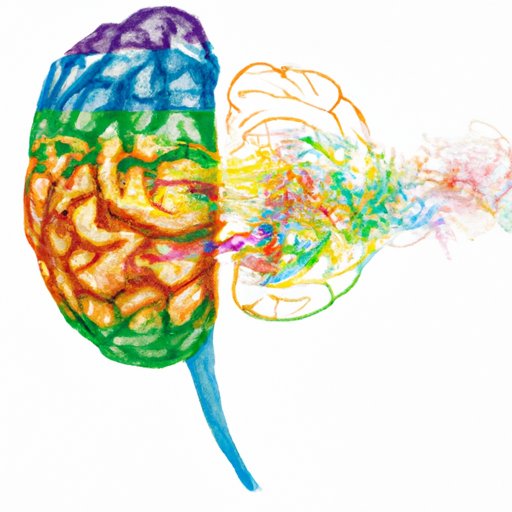Which Side of the Brain is Creative?
For many years, people have believed that creativity is located predominantly in one side of the brain. It has been widely believed that the right hemisphere of the brain, associated with intuition, emotions, and art, is responsible for creativity, while the left hemisphere, which is linked to logic and math, is not. Is creativity truly a one-sided matter, or is there more to the story?
It is essential to understand the truth about brain lateralization and creativity, as it affects how we approach creativity and how we conceptualize the human brain. In this article, we will examine the current understanding of creativity and how it relates to brain lateralization. We will also explore some of the myths surrounding creativity and the brain.
The Science Behind Creativity: Debunking the Myth of Left vs Right Brain
The myth of left and right brain dominance originates from the 1960s, when researchers used split-brain patients to study the lateralization of the brain. They found that, in most people, certain functions are located in specific regions of the brain. For example, the language center is usually found in the left hemisphere of the brain. This research led to the belief that the left hemisphere was responsible for logical and analytical thinking, and the right hemisphere controlled creativity and emotion.
In later years, this simplistic view of the brain was challenged. More recent research has shown that the brain is much more complex than previously believed. The idea that one side of the brain is responsible for creativity while the other is not has been debunked. Both sides of the brain are involved in creative thinking in different ways.
Unlocking Your Creative Potential: Discovering the Role of Both Hemispheres of Your Brain
Both hemispheres of the brain play complementary roles in creative thinking. While the right hemisphere is more intuitive and imaginative, the left hemisphere is essential for logical and analytical reasoning. The two hemispheres of the brain work together to create a more holistic approach to the creative process.
The right hemisphere of the brain is responsible for divergent thinking, which is the ability to come up with multiple solutions to a problem. It is also involved in recognizing patterns and making connections between seemingly unrelated ideas. The left hemisphere, on the other hand, is responsible for convergent thinking, which is the ability to analyze and synthesize information to come up with a single solution. It is also responsible for language processing, critical thinking, and decision-making.
Both hemispheres are essential for creativity, and it’s vital to engage both hemispheres to increase creative potential. Engaging in activities that involve both logical and intuitive thinking, like playing music or doing crossword puzzles, can help stimulate both sides of the brain and encourage more creative thinking.
Why Your Brain Works Like It Does: Understanding the Relationship Between Creativity and Brain Lateralization
Brain lateralization is the process through which certain functions develop in specific regions of the brain. Factors such as genetics, upbringing, and life experiences can all affect brain lateralization. It is essential to understand that everyone’s brain works differently, and there are varying degrees of lateralization in each individual.
Environmental factors can also influence brain lateralization. Studies have shown that environmental factors such as language, music training, and reading can affect the development of particular regions of the brain. For example, bilingualism has been shown to enhance gray matter density in language-related areas of the brain.
There is also ongoing research on how creativity affects the brain. Research has shown that engaging in creative activities like art and music can increase brain connectivity and brain plasticity. Creativity has also been linked to decreased stress, improved mood, and increased self-esteem.
Creativity and the Brain: Exploring the Connection Between Hemispheric Dominance and Artistic Innovation
Various forms of creative expression, like painting and writing, require different types of thinking, and different types of lateralization may impact performance in these areas.
Studies have shown that visual artists have a greater degree of lateralization in the right hemisphere of their brain, while writers tend to have more lateralization in the left hemisphere. However, it’s important to note that these are generalizations, and there is no one-size-fits-all approach to creativity and lateralization.
Individual differences in creativity and lateralization should be seen as strengths rather than limitations. Creativity is not just a matter of having the “right brain” or “left brain” dominance. It is essential to recognize the complexity of the human brain and embrace individual differences to promote creativity and innovation.
Left Brain, Right Brain: Myths and Facts About How Your Brain Drives Creativity
It’s essential to understand that the left-brain/right-brain myth has been debunked. While the two hemispheres have different functions, they work together to promote creative thinking. Additionally, there are other myths about brain lateralization that should be dispelled.
For example, it’s commonly believed that left-brained people are better at math and science, while right-brained people are better at art and music. However, this is not necessarily the case. Everyone has the potential to excel in both areas, and many factors beyond lateralization affect performance.
Furthermore, brain lateralization is not fixed. The brain is highly adaptable and can change in response to new stimuli and experiences. Engaging in creative activities can help to strengthen connections between different areas of the brain and promote greater creativity.
Conclusion
In conclusion, the idea that one side of the brain is responsible for creativity while the other is not is a myth that needs to be addressed. Both hemispheres of the brain are essential for creative thinking, and engaging both sides can lead to increased innovation and productivity. It’s essential to embrace individual differences in brain lateralization and recognize that everyone’s brain works differently. Creativity should be seen as a strength that promotes innovation and self-expression, not a limitation.
